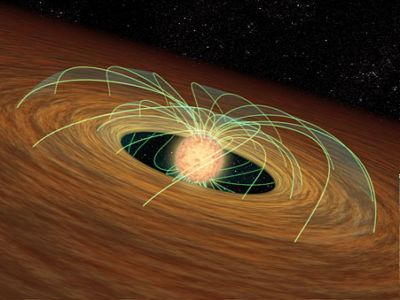The outflows from cool stars have been classified into two broad categories, linked by a possibly distinct intermediate state.
-
"Hot" solar-type winds are accelerated in
extended coronae (temperatures exceeding 1 million K) and typically
have low mass loss rates (less than 10^(-12) solar masses per year).
Our understanding of
solar wind acceleration has increased
dramatically over the past decade thanks in part to new
remote-sensing and in situ measurements.
-
Cool, evolved stars exhibit chromospheres
(temperatures around 10,000 K and lower),
winds with high mass loss rates (at least 10^(-7) solar masses
per year), and terminal wind speeds
seemingly smaller than their surface escape speeds.
- In between these two groups, the so-called hybrid-chromosphere stars exhibit moderately hot outer atmospheres (temperatures greater than about 100,000 K) with wind speeds and mass loss rates between those of the "cool" and "hot" classes.
-
We've begun to construct
unified models of the turbulent photospheres, chromospheres,
X-ray coronae, and stellar winds of low-mass main sequence stars
and evolved giants.
Cranmer
and Saar (2011)
developed a predictive model for the mass loss rates of
a broad swath of stars, and found that it produced better statistical
agreement with observations than any published scaling law.
This model also produced excellent agreement with the properties of a
young nearby M dwarf
(AU
Microscopii)
observed from X-ray to radio wavelengths.
-
Extending cool-star models to the complex environments of
young stars that are still accreting gas from the interstellar
cloud in which they were born; see
Cranmer (2008)
and
Cranmer (2009).
X-ray data from Chandra has been key in putting constraints
on these theoretical flights of fancy
(see
Brickhouse
et al. 2012).

- Much of the hot plasma that eventually fills the space around low-mass stars has its origin in tiny magnetic "flux tubes" that sit in narrow lanes between the chaotic convective cells in the star's atmosphere. Thus, it's important to know as much as we can about the so-called stellar granulation that is a key lower boundary condition for all kinds of high-energy activity. Recently, we were able to make use of high quality light curves of stars from the Kepler planet-hunting mission to learn more about how granulation behaves as a function of stellar mass and age (see Van Kooten et al. 2021).